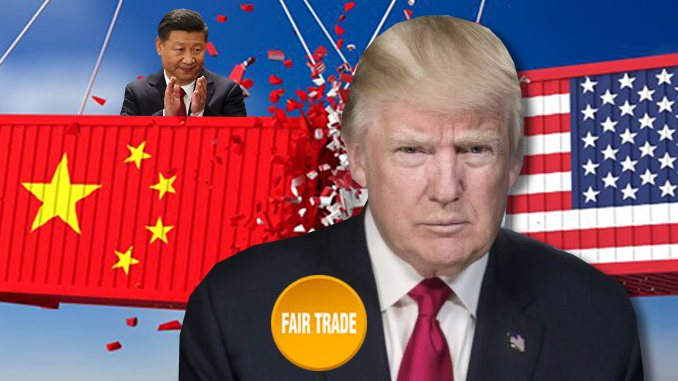
Tariffs, while they’re not a cure-all, serve an important dual function—to bring about an increase in tax revenue at the water’s edge … and to protect the economy from excessive imports and thereby spur an increase in domestic production. Pat Buchanan reminds us tariffs are “the taxes that made America great.”
By Mark Anderson
What the big-box media calls a “trade war” between the U.S. and China is, in reality, hard-nosed but vitally necessary negotiations in which the Trump administration is showing some fortitude in pursuing long-overdue adjustments to begin reducing China’s notoriously lopsided, long-term trade surplus with the U.S. President Donald Trump’s key tool in this process is the application of tariffs against Chinese imports over the last few months—largely for the purpose of improving America’s industrial sector by spurring domestic production.
Tariffs, while they’re not a cure-all across the board, serve an important dual function—to bring about an increase in tax revenue at the water’s edge to help the U.S. balance its books and resist the urge to raise domestic taxes, and to protect the economy from excessive Chinese imports and thereby spur an increase in domestic production. This production boost would translate into more buying power to purchase the productive output amid a gradually reduced reliance on imports.
But this upside to tariffs gets lost in the reports issued by a mass media cartel that puts undermining Trump ahead of all else. Helping set the record straight, the non-partisan Coalition for a Prosperous America (CPA) announced May 9 that a Department of Commerce report showed “that the monthly U.S. goods deficit with China fell to just $20.7 billion in March. That’s the smallest monthly deficit with China since March 2014.”
“In the face of continuing pressure from multinational interests and the import lobby, President Trump has stayed the course on China tariffs,” CPA Chairman Dan DiMicco remarked. “To the president’s credit, the tariffs are working. America’s manufacturers and workers are now seeing gains as manufacturing employment rises and China’s hold on the U.S. market shrinks.”
Michael Stumo, CEO of the CPA, added: “This is exactly what we were hoping to see when the president applied tariffs [to aid] important industries that have been facing heavily subsidized competition from China’s state-owned enterprises. We expect the next round of tariffs to have a positive effect to improve the U.S. economy and address Beijing’s continuing economic aggression.”
CPA Chief Economist Jeff Ferry, having examined the new Commerce Department data, found that the improvement in America’s goods deficit with China “has come largely through a reduction in imports.” He added: “While U.S. exports to China were $10.4 billion in March [2019]—a figure $1.9 billion lower than in March 2018—total imports reached only $31.2 billion, a full $7 billion less than the March total for 2018,” which was the lowest monthly China import level in five years. Furthermore, while 2018 imports from China averaged $44.9 billion a month, so far in 2019 they’re averaging just $35 billion—and are falling each month, according to the CPA.
“The United States economy continued to thrive in April,” the White House announced, “with the unemployment rate dropping to 3.6%—the lowest unemployment rate since December 1969, according to the Bureau of Labor Statistics’ (BLS) household survey. April also marks the 14th consecutive month of the unemployment rate being at or below 4%. The U-6 unemployment rate, a broader measure of unemployment that includes those who are unemployed, marginally attached to the labor force, and working part-time . . . remained at 7.3% in April, matching the lowest U-6 rate since December 2000.”
While the White House concedes that recent job gains “were predominantly concentrated in professional and business services (76,000 new jobs), education and health services (62,000 new jobs), and leisure and hospitality (34,000 new jobs),” and while “the construction sector added 33,000 new jobs in April and has added 669,000 jobs since the 2016 election,” it’ll be interesting to see what happens when tariffs to limit Chinese imports and produce more goods domestically sink in and have time to adjust the economic dials.
Mark Anderson is AFP’s roving editor. Email him at [email protected].
Tariffs: The Taxes That Made America Great
Before globalism became the law of the land, tariffs protected and enriched the American people.
By Patrick J. Buchanan
As his limo carried him to work at the White House Monday, Larry Kudlow could not have been pleased with the headline in The Washington Post: “Kudlow Contradicts Trump on Tariffs.” The story began: “National Economic Council Director Lawrence Kudlow acknowledged Sunday that American consumers end up paying for the administration’s tariffs on Chinese imports, contradicting President Trump’s repeated inaccurate claim that the Chinese foot the bill.”
A free-trade evangelical, Kudlow had conceded on “Fox News” that consumers pay the tariffs on products made abroad that they purchase here in the U.S. Yet that is by no means the whole story.
A tariff may be described as a sales or consumption tax the consumer pays, but tariffs are also a discretionary and an optional tax. If you choose not to purchase Chinese goods and instead buy comparable goods made in other nations or the USA, then you do not pay the tariff.
China loses the sale. This is why Beijing, which runs $350 billion to $400 billion in annual trade surpluses at our expense, is howling loudest. Should Donald Trump impose that 25% tariff on all $500 billion in Chinese exports to the U.S., it would cripple China’s economy. Factories seeking assured access to the U.S. market would flee in panic from the Middle Kingdom.
Tariffs were the taxes that made America great. They were the taxes relied upon by the first and greatest of our early statesmen, before the coming of the globalists Woodrow Wilson and FDR.
Tariffs, to protect manufacturers and jobs, were the Republican Party’s path to power and prosperity in the 19th and 20th centuries, before the rise of the Rockefeller Eastern liberal establishment and its embrace of the British-bred heresy of unfettered free trade. The Tariff Act of 1789 was enacted with the declared purpose, “the encouragement and protection of manufactures.” It was the second act passed by the first Congress led by Speaker James Madison. It was crafted by Alexander Hamilton and signed by President George Washington.
After the War of 1812, President Madison, backed by Henry Clay, John Calhoun, and ex- Presidents Thomas Jefferson and John Adams, enacted the Tariff of 1816 to price British textiles out of competition so that Americans would build the new factories and capture the booming U.S. market. It worked.
Tariffs financed Abraham Lincoln’s war. The Tariff of 1890 bears the name of Ohio Rep. and future President William McKinley, who said that a foreign manufacturer “has no right or claim to equality with our own. . . . He pays no taxes. He performs no civil duties.”
That is economic patriotism, putting America and Americans first.
The Fordney-McCumber Tariff gave Presidents Warren Harding and Calvin Coolidge the revenue to offset the slashing of Wilson’s income taxes, igniting that most dynamic of decades— the Roarin ’20s.
That the Smoot-Hawley Tariff caused the Depression of the 1930s is a New Deal myth in which America’s schoolchildren have been indoctrinated for decades.
The Depression began with the crash of the stock market in 1929, nine months before Smoot- Hawley became law. The real villain: the Federal Reserve, which failed to replenish that third of the money supply that had been wiped out by thousands of bank failures. Milton Friedman taught us that.
A tariff is a tax, but its purpose is not just to raise revenue but to make a nation economically independent of others and to bring its citizens to rely upon each other rather than foreign entities. The principle involved in a tariff is the same as that used by U.S. colleges and universities that charge foreign students higher tuition than their American counterparts.
What patriot would consign the economic independence of his country to the “invisible hand” of Adam Smith in a system crafted by intellectuals whose allegiance is to an ideology, not a people? What great nation did free traders ever build?
Free trade is the policy of fading and failing powers, past their prime. In the half-century following passage of the Corn Laws, the British showed the folly of free trade.
They began the second half of the 19th century with an economy twice that of the U.S. and ended it with an economy half of ours, and equaled by a Germany, which had, under Bismarck, adopted what was known as the American system.
Of the nations that have risen to economic preeminence in recent centuries—the British before 1850, the United States between 1789 and 1914, post-war Japan, China in recent decades— how many did so through free trade? None. All practiced economic nationalism. The problem for President Donald Trump?
Once a nation is hooked on the cheap goods that are the narcotic free trade provides, it is rarely able to break free. The loss of its economic independence is followed by the loss of its political independence, the loss of its greatness, and, ultimately, the loss of its national identity.
Brexit was the strangled cry of a British people that had lost its independence and desperately wanted it back.
Pat Buchanan is a writer, political commentator and presidential candidate. He is the author of Nixon’s White House Wars: The Battles That Made and Broke a President and Divided America Forever and previous titles including The Greatest Comeback: How Richard Nixon Rose From Defeat to Create the New Majority, Suicide of a Superpower: Will America Survive to 2025? and Churchill, Hitler and the Unnecessary War, all available from the AFP Online Store.
COPYRIGHT CREATORS SYNDICATE, 2019








